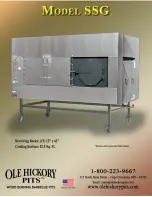
System
The Genelec HT312B and HT315B are three-
way active home theater loudspeaker sys-
tems including drivers, multiple power ampli-
fiers and active crossovers. The systems
are designed for room volumes up to 175
m
3
/
6200 ft
3
(HT312B) or 250 m
3
/ 8800 ft
3
(HT315B) with maximum listening distances
up to 6.1 - 7.6 meters (20-25 ft). They are
designed to perform well both as free-stand-
ing or flush mounted into the wall structure.
The unique Directivity Control Waveguide™
(DCW™) Technology developed by Genelec
provides stable and extremely accurate imag-
ing and frequency balance even in difficult
acoustic environments. Designed as active
loudspeakers, each system contains an
individually matched amplifier unit with mul-
tiple power amplifiers, active crossover filters
and protection circuitry. The fast, low distor-
tion amplifiers are capable of driving a stereo
system to peak output levels in excess of 124
dB SPL at 2 m (HT315B) or 123 dB SPL at 2 m
(HT312B) with music material. Versatile cross-
over controls allow for precise matching of the
loudspeakers to different acoustic conditions.
Drivers and
cabinet construction
On the HT315B the low frequencies are
reproduced by an 385 mm (15”) bass driver
loaded with a 110 liter vented box. The
-3 dB point is 33 Hz and the low frequency
response extends down to 29 Hz (-6 dB). The
HT312B features a 305 mm (12”) bass driver
in a 65 liter vented box with the -3 dB point at
35 Hz and -6 dB at 32 Hz.
Both models share the same midrange and
high frequency driver layout with a proprietary
130 mm (5”) direct radiating cone for the MF
and a 25 mm (1”) metal dome for the HF loaded
by proprietary Directivity Control Waveguide.
All drivers are magnetically shielded.
Amplifiers
The amplifiers, crossover filters and power
supply of the HT312B and HT315B are inte-
grated into a 19” 3U RAM4/5 rack module.
The bass, midrange and treble amplifiers
of the RAM4 amplifier powering the HT312B
produce 180 W, 120 W and 120 W of short
term power. Respectively, the RAM5 ampli-
fier provided with the the HT315B produces
400 W, 120 W and 120 W. The amplifiers are
designed to operate at very low THD and
IM distortion values and incorporate special
circuitry for driver overload protection and
amplifier thermal protection.
Neutrik Speakon connectors are included
to facilitate wiring and system connection at
customer facilities. Each amplifier is factory
calibrated with the individual loudspeaker
they are shipped with in order to eliminate the
effects of component tolerances and ensuring
consistent quality and long term reliability.
Crossover filters
The active crossover network consists of
three parallel bandpass filters. The crosso-
ver frequencies are 410 Hz and 3.0 kHz on
the HT315B and 420 Hz and 3.2 kHz on the
HT312B. Bass, midrange and treble Level
controls with 1 dB steps are included in the
crossover to obtain uniform frequency bal-
ance in different acoustic conditions. The low
frequency Tilt and Roll-Off controls both have
four 2 dB steps to allow refined low frequency
response tailoring. The crossover network is
driven by an active balanced input stage, fed
by a 3 pin XLR connector. Variable input sen-
sitivity allows for accurate level matching to
the signal source output.
Installation
Each loudspeaker is supplied with an ampli-
fier unit, a mains cable, Neutrik Speakon
connectors and an operating manual. Once
unpacked place the loudspeaker in its
required listening position, taking note of the
line of the acoustical axis (see Figure 1).
Sufficient cooling for the RAM4/5 ampli-
fier must be ensured. The cooling fan on
the amplifier back panel draws air through
the filter on the left side panel and blows the
warmed air to the space behind the amplifier.
The airflow must not be obstructed. Note also
that the space behind the amplifier must either
be ventilated or sufficiently large to dissipate
heat so that the ambient temperature does not
rise above 35 degrees Celsius (95°F).
Before connecting up, ensure that the
mains switch is off (see Figure 2). Check that
the mains voltage selector is correctly set to
your local voltage.
Connections
Each system is delivered with two 8-pole
and two 4-pole Speakon cable connectors
for constructing signal cables of desired
length.
Measure the required lengths of 8-pole
and 4-pole cable and secure the connec-
tors on them pin to pin. See Table 1 below for
recommended cable thicknesses. The whole
cable should have an outside diameter of 8 to
20 mm (5/16" to 13/16") to fit in the Speakon
connector.
Alternatively, pre-terminated lengths of
cable are available from Genelec.
Be sure not to mix the amplifier/loudspeaker
pairs when installing multiple loudspeakers
at the same time. Each amplifier and loud-
speaker delivered together are marked with
the same identification number and calibrated
together for optimal performance.
Audio input is made via a 10 kOhm bal-
anced XLR connector, but unbalanced leads
may be used as long as pin 3 is grounded to
pin 1 of the XLR. Once connection has been
made, the loudspeakers are ready to be pow-
ered-up.
Access to the
front panel controls
The decorative front panel of the amplifier
is held in place by guide pins and two mag-
nets. To remove the panel, pull it straight
out.
Setting the input sensitivity
Adjustment of the input sensitivity of each
loudspeaker can be made to match the
output of the decoder or other signal source
by use of the input sensitivity control on the
amplfier front panel. A small screwdriver is
needed for the adjustment. The manufacturer
default setting for this control is -6 dBu (fully
clockwise) which gives an SPL of 100 dB
Genelec HT312B and HT315B Active 3-Way Speaker Systems
Cable gauge
Max. length
2,0 mm
2
(14 AWG)
30 m (100 ft)
3,3 mm
2
(12 AWG)
40 m (130 ft)
5,3 mm
2
(10 AWG)
60 m (200 ft)
Table 1. Recommended cable thicknesses for
different lengths of cable
























